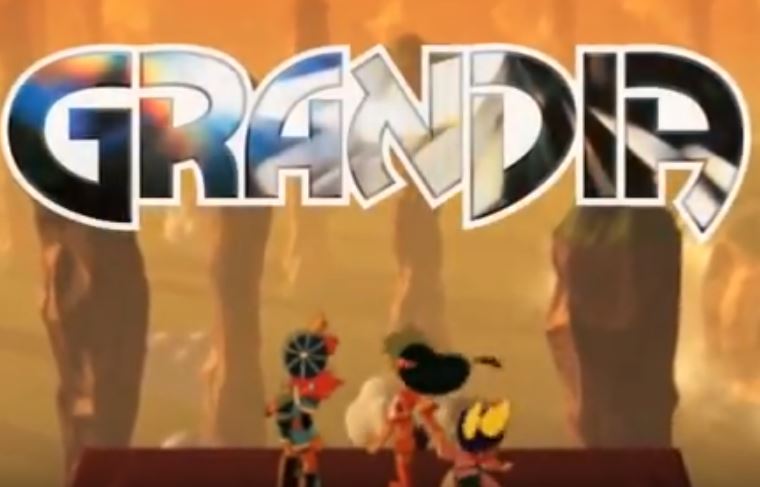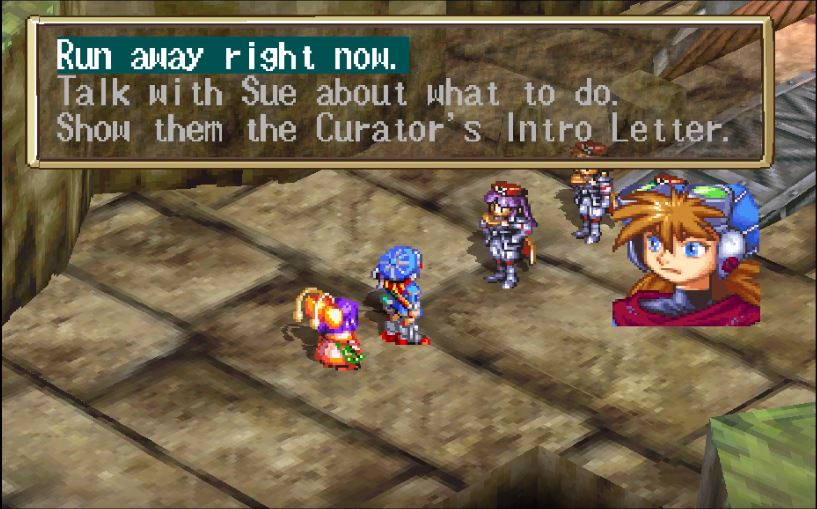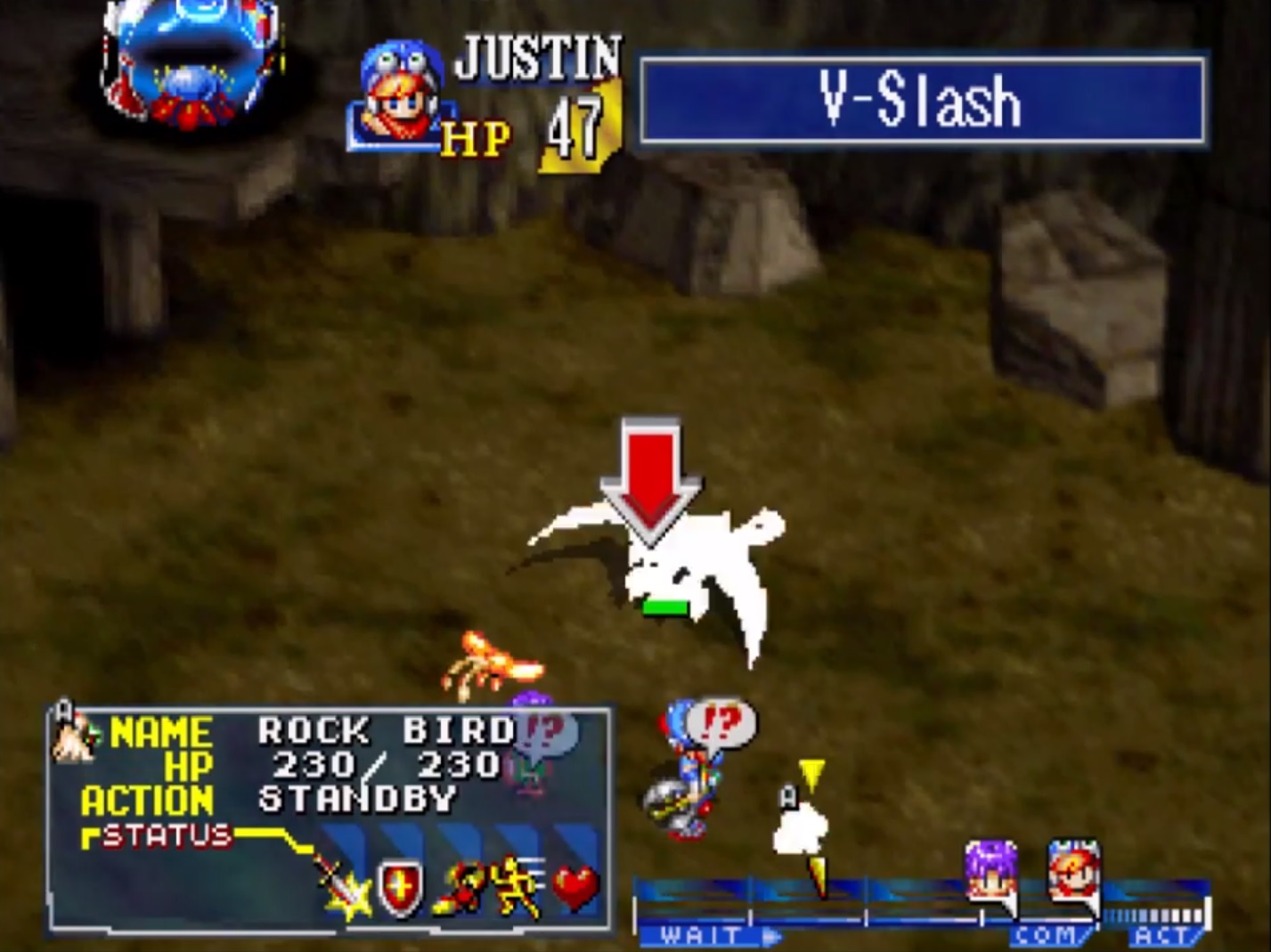PlayStation Top 10
After the announcement of the PlayStation Classic I decided to look back at my personal Top 10 PlayStation games to see if they hold up. Each gets a minimum of 3 hours of game play before I compare how I remember the game and how it plays now.
The rest of my Top 10 games are:
- Castlevania: Symphony of the Night
- Motoracer
- Crash Warped
- Resident Evil
- Quake 2
- Metal Gear Solid
- Final Fantasy VII
- Lunar: Silver Star Story Complete
- Lunar 2: Eternal Blue Complete
Grandia – Then (1999/2012)
Grandia is the only game on this top 10 list I did not known during the PlayStation generation. My first experience playing Grandia came as a PSN download on my PlayStation 3 just five years ago. I had stopped playing JRPGs regularly after Final Fantasy X-2 and Dragon Quest 8 failed to spark my imagination. It took Xenoblade Chronicles on the Wii to bring me back to the genre. Once I saw who created Grandia, I knew I had to try it.
Created by Gamearts, Grandia released in North America on October 26 1999. Gamearts created my two favorite PlayStation games of all time, Lunar 1 & 2. Had I known the connection at the time of release, Grandia would have been a must buy. Growing up in a small town in Northern Ontario made knowing these kinds of details difficult. The internet was still relatively new, and outside of Final Fantasy JRPGs didn’t get a ton of magazine coverage. I was aware of Grandia, but it came and went without any fanfare. I remember seeing it on shelves and passing it by…missed opportunity.
That sums up the overall place Grandia has in the larger video game culture. It’s a niche title that gets some recognition among JRPG fans, but it’s not considered a masterpiece. Not helping its North American release was the massive delay from the Japanese launch. Original for the Sega Saturn, that version was never translated; Grandia hit Japan Dec 18 1997. The PlayStation port lunched June 24 1999 in Japan, and October 26 1999 in North America.
Grandia should have competed against Final Fantasy VII, but released against Final Fantasy VIII. The hype train for Square’s new FF was massive. Square also stole some of Grandia’s thunder with Xenogears in 1998, which had a similar, but more technically impressive, graphical style. Poor Grandia got lost in the shuffle. This lack of popularity made the game rare, and drove its price through the roof. It became difficult and expensive to play, until the PSN release for $6.99.

Less than $10 made Grandia a steal. When I played it for the first time, I was an adult with a full time job and baby. My daughter slept on my lap while I explored dungeons and story quests. I finished the game just as she started being able to reach up and swat the controller from my hands.
Every moment of the game was enjoyable, but it’s not perfect. Experience taught me how games work and my career gave me an eye for management systems. Despite being more critical and aware of its flaws, Grandia sucked me into its experience. It’s a game of fun and adventure. I loved it. Let’s find out if anything has changed in six years.
Grandia – Now (2018)
Grandia is the story of Justin and his friend (essentially little sister) Sue leaving their quaint town to go on a grand adventure. It tells a familiar story with standard character archetypes, but it nails what makes those stories and archetypes so enduring. Justin always sees the positive side of life as he pushes toward the next adventure. His excitement at exploring the world around him is infectious. You need to get Justin to the next town or dungeon. You don’t play Justin; you become Justin the adventurer.
Sue’s character arc takes a different path. The game begins with her and Justin playing a game. They’re children playing make believe. Sue is eight years old. After Justin discovers an ancient holographic message that tells him to explore the world, Sue decides to sneak along on his journey. As the game progresses, Sue shares in Justin’s adventures but views them very differently. They’re both young, but Sue is still very much a child.
Sue experiences an epiphany half way through the game. It’s a beautiful moment of self-realization that isn’t typical of JRPG narratives. *Spoiler* After all the violent encounters and near death experiences they’ve encountered, Sue decides to go home. She doesn’t want to continue the journey and leaves Justin. It makes absolute sense for the character, who often seems older than she is, but finally acknowledges that she’s a child and can’t handle all that’s happening around her.

After Sue’s departure, Feena becomes the games number two to Justin. She’s an experienced adventurer, who Justin instantly becomes enamored with. In typical anime style they fall into a will they/won’t they romance cliché. Thankfully, with the characters’ ages it comes across as sweet rather than unrealistic and trite. They’re teenagers, not adults.
Coming back to these characters hasn’t changed my opinion of them in the least. Old friends I want to revisit. I feel the pull to keep playing, rather than moving onto my next game in the top 10. Grandia has that ability. It will suck you into its charming little adventure.
Grandia’s characters are stronger than its plot. The story begins with Justin discovering a holographic message urging him to find the lost civilization of Alent. His search leads across the known and unknown parts of the world. At the same time, the Garlyle military forces seeking Alent for ancient technology to conquer the world.

The story is nothing new, but supports the game play and character arcs. It keeps Justin and his friends moving from place to place, engaging in battles in a way that makes sense. Each area wraps up before it wears out its welcome. Replaying the game, the opening town of Parm was starting to grow dull, but then we’re on our way to the next area of the world. Perfect timing.
Grandia isn’t all story and character, the game play is excellent too. With any JRPG the battle and leveling systems are the majority of the game play. Grandia’s battle system is my favorite of all time. The sequel perfected it, but this first attempt still blows the competition away. Fast paced but thoughtful, there’s a lot to learn. A quasi-real time system balance menu driven decisions and critical timing.
In the lower right of the screen is the action bar. All characters in the battle appears as an icon on the bar, moving from left to right. Movement speed depends on their individual stats. Some move faster, others slower. Knowing your characters, speed affects your battle strategy.
Characters start in the WAIT section of the action bar. 3/4s of the way across is the COM section, where the game pauses so you can select characters actions. The last ¼ of the bar is the ACT delay. Once you’ve chosen what the character will do, their icon must finish traveling across the bar executing the action. Speed and timing are important elements of the game’s strategy. You and the enemy AI can take advantage of the feature.
CRITICAL attacks are especially important to the battle system. If the attack strikes a character in ACT section, they are knocked back on the action bar. Multiple CRITICAL hits from your party can keep an enemy from landing a hit for a long time. Against bosses, this strategy can mean the difference between life and death.
Balancing this system is the enemy’s access to the same moves and tactics. The AI can trap your characters in the same critical hit loop. Grandia isn’t especially difficult, but I did find myself stuck in a knock back loop once or twice, right while trying to heal.

Adding more depth to battles is the use of space. Executing a physical attack means moving toward your opponent. If you’re close to the enemy, you’ll strike quick. If there’s a gap, your character needs to close it. Crossing the battlefield affects the timing of critical attacks. You have limited time to land the blow and can miss your opportunity if the enemy is too far away.
Magic doesn’t consider your movement across the battlefield, but it does have an area of attack. Knowing you’ll hit multiple or a single enemy impact choice. Magic can also slow the characters movement across the ACT section, which leaves them more vulnerable to attack.
Switching between magic and physical attacks is important, because weapons and magic gain levels through use. Fail to use a spell and it’ll remain low leveled. Leveling your favorite spells can lead to grinding. Fighting just to raise your stats. There’s a few sections where the environmental traps can hurt your party outside of battle. I found myself grinding these locations for healing spells. Get hit, heal yourself, level up your healing. Repeat for 20 minutes and your healing doubles.
Weapons have the same leveling system. Justin can wield swords, axes and hammers. Using one type increases his skills with that specific weapon type. It doesn’t seem like a problem, master your favorite weapon, but it becomes a problem later on. In the Misty Forest, there are tree monsters that I thought were immune to all physical hits. I wasted so much SP on fire magic killing them, and it turns out an ax will do the job. Trees killed by fire and axes, makes sense. Problem was, I had never used the ax. Equipping it mean Justin could land a physical attack, but it was severely under powered.
The leveling system is the game’s biggest problem. Maxing magic spells takes too much time. Balancing weapon usage becomes an annoying trend you have to account for. This system was simplified for the sequel and works much better. It doesn’t stop me from enjoying Grandia, but it’s a low point.
Similar to his work on the Lunar games, while having its own distinct themes, Noriyuki Iwadare’s soundtrack is a high point in Grandia. I find myself listening to it when I’m walking to work or writing a blog post. It’s that catchy. The main theme especially great, perfectly capturing the games sense of adventure and exploration.
The same cannot be said for the English voice acting. Cringe worthy from start to finish, listening to the “actors” fumble their way through the dialogue is a painful experience. There’s not a single good piece of voice work I can highlight. The best part of the voice acting is how rarely it occurs. There’s so little its easy enough to ignore.

Another let down will be the graphics. The world of Grandia is rendered in 3D with muddied textures and simple models, while characters are animated 2D sprites. The game has the same basic visual style as Xenogears, but lacks the graphical fidelity of Square’s title. There’s nothing impressive about how Grandia looks. Battles fair a little better, as the focus there is the 2D sprite work. They’re not particularly impressive, but they’re not bad. Nobody should play Grandia for the graphics, but don’t let them stop you from experiencing the amazing core game play.
Revisiting Grandia is a fantastic experience. I love the world and characters. The battle system is amazing. The leveling system sucks, but it doesn’t hurt enough to make me reconsider the game as a whole. An HD remake of Grandia 1 & 2 have been announced for PC and Switch. As much as I love the PlayStation original, I recommend holding out to see how the new version looks. If any game deserves to be spruced up, it’s Grandia.
Grandia Retrospective Review
Summary
Pros
-Best JRPG battle system ever
-Fun characters and plot
-Addictive sense of adventure
Cons
-3D graphics are an eye sore
-voice acting is horrendous
Finish it!

